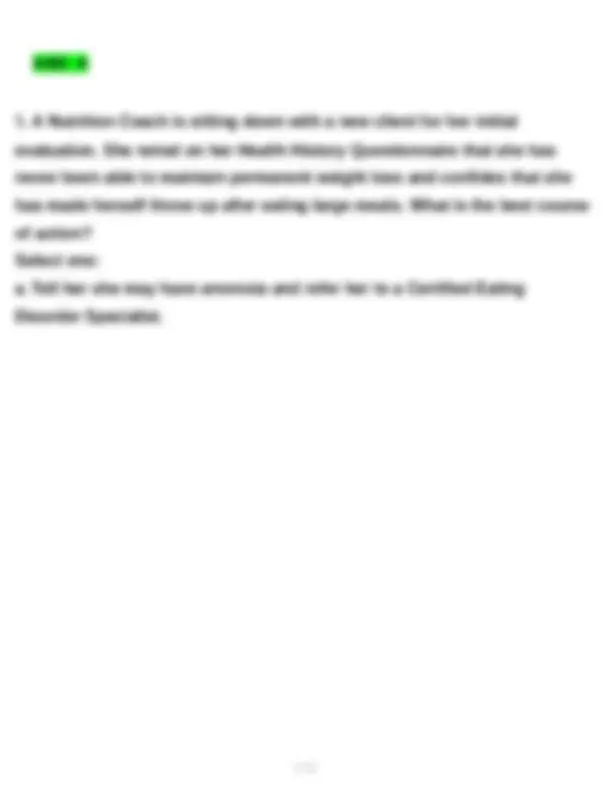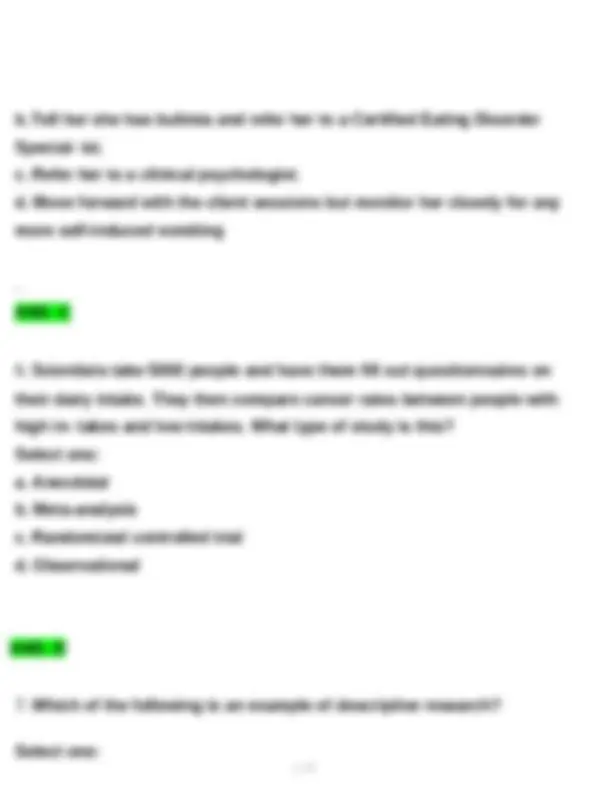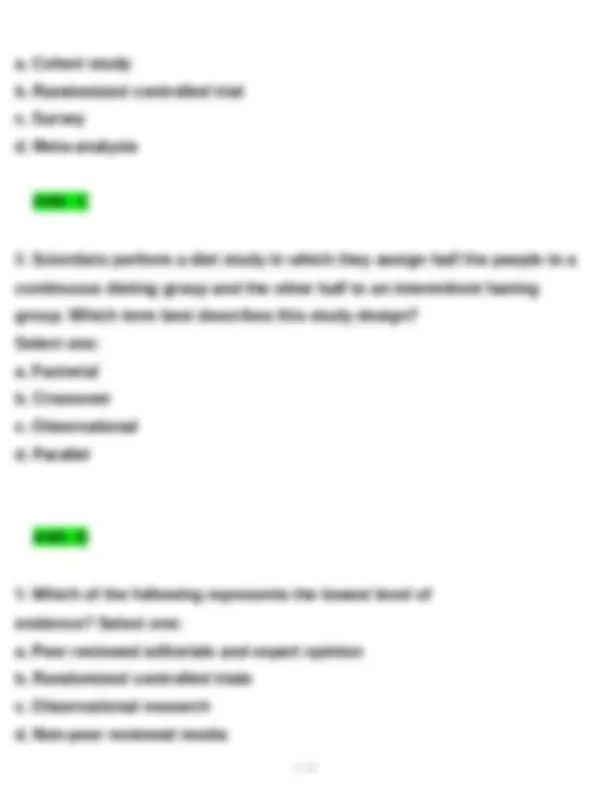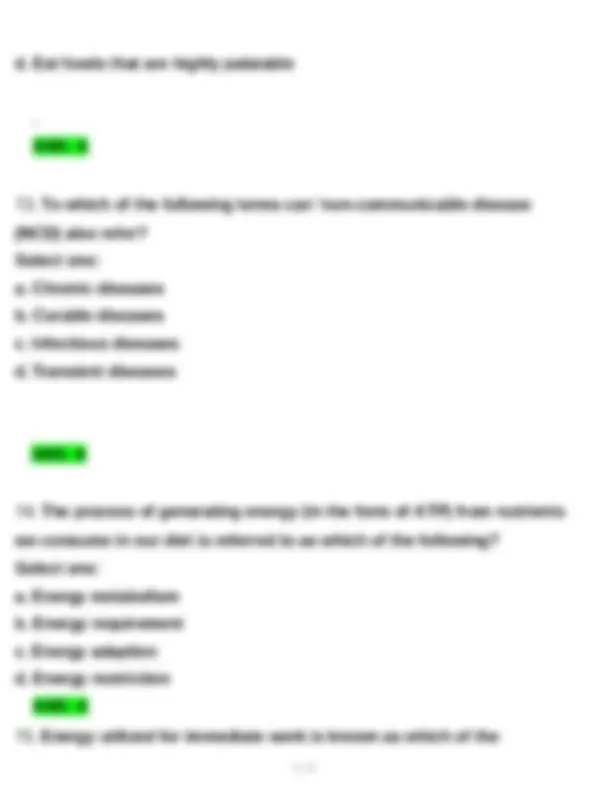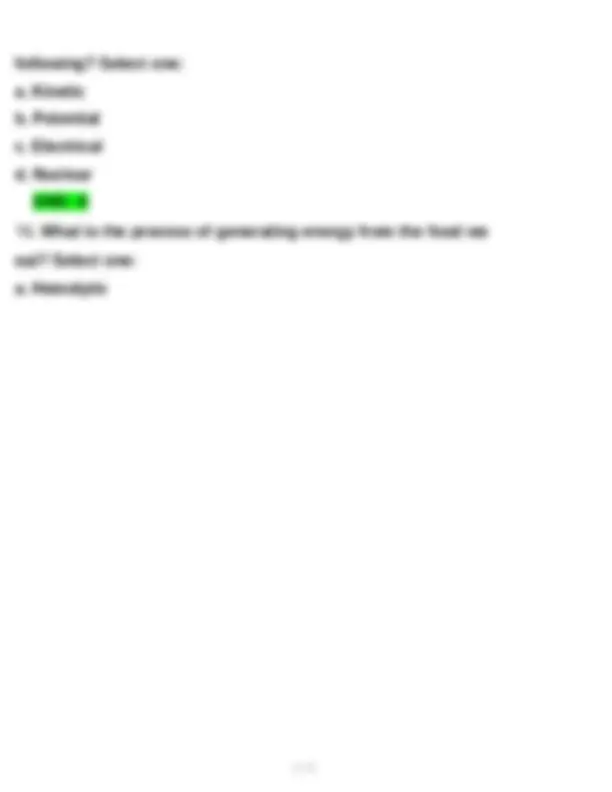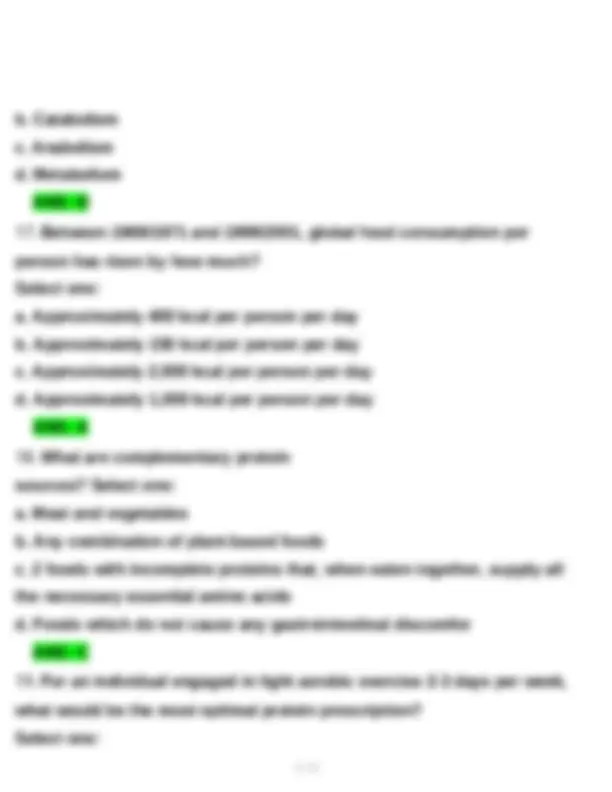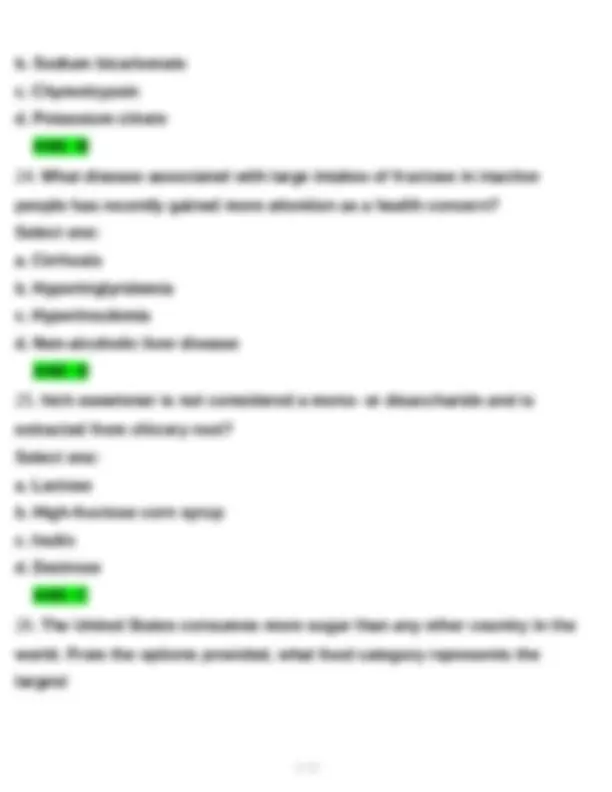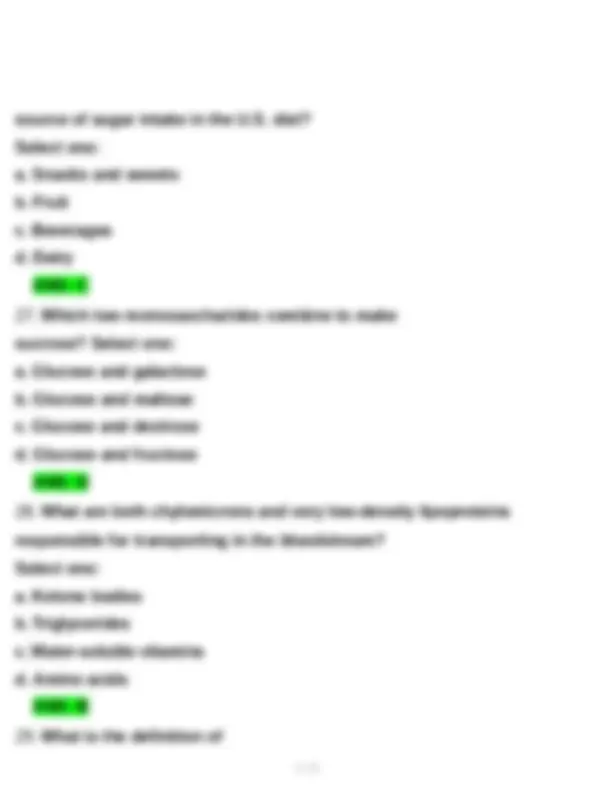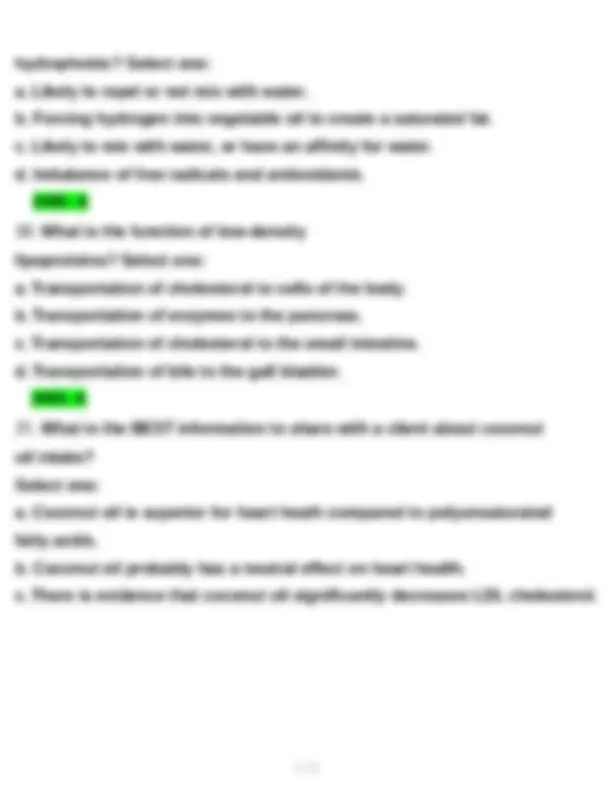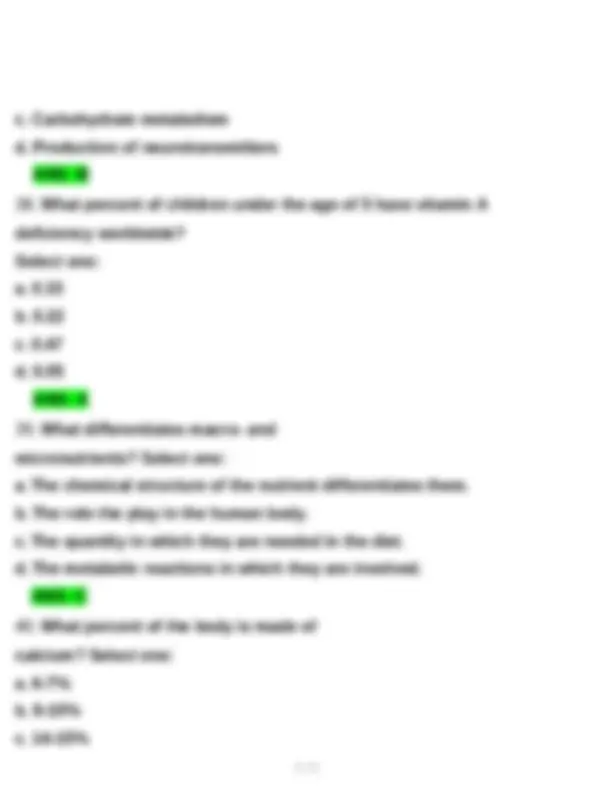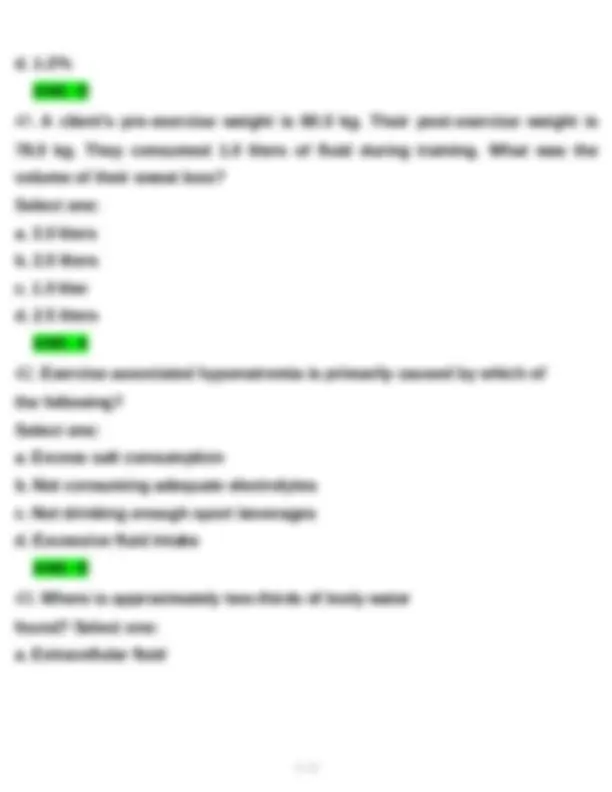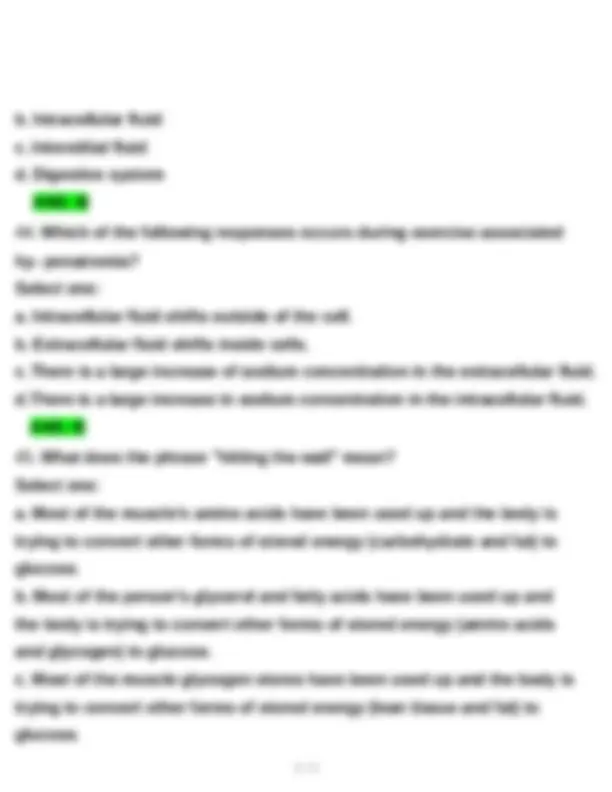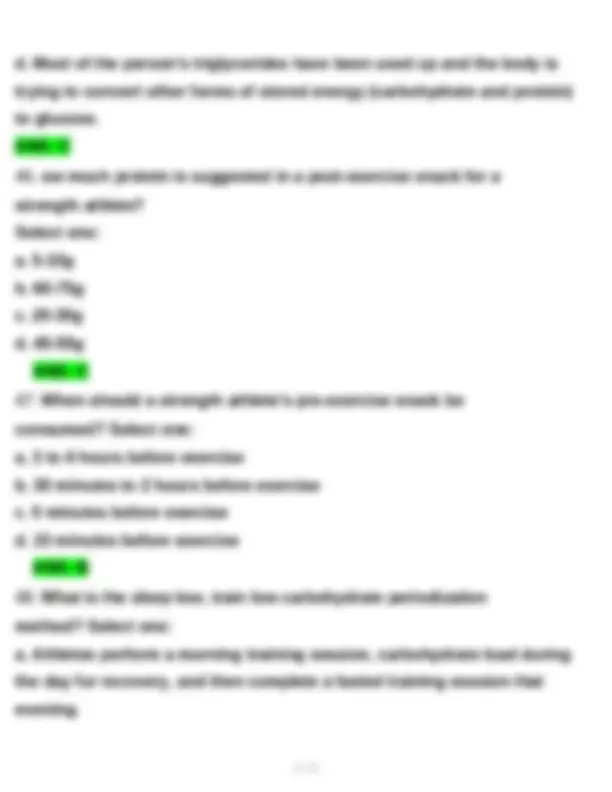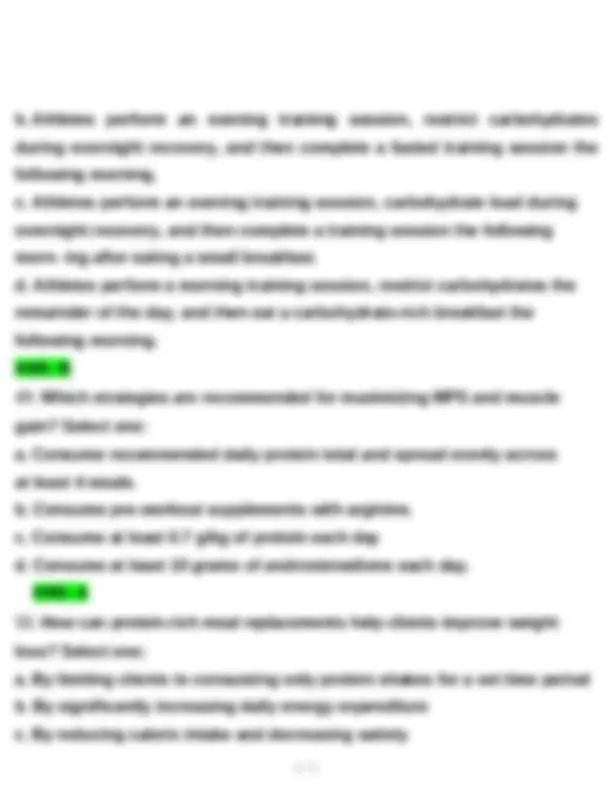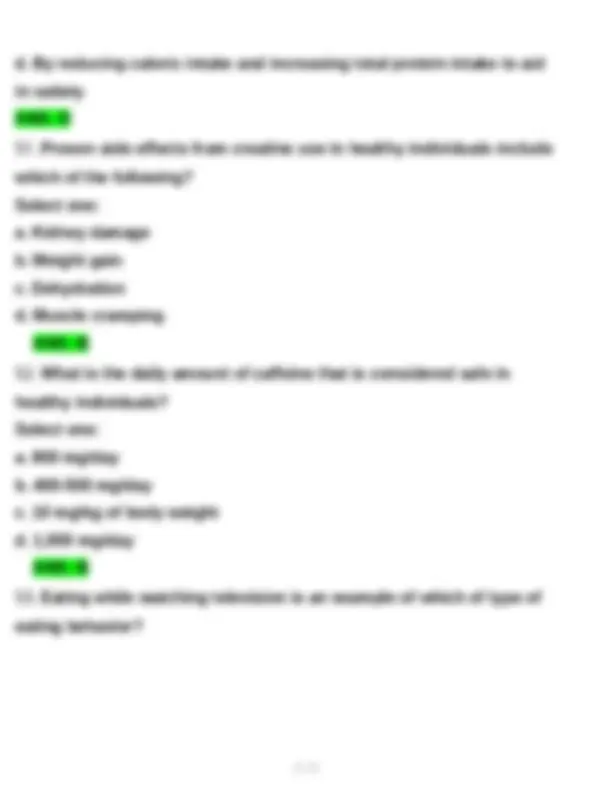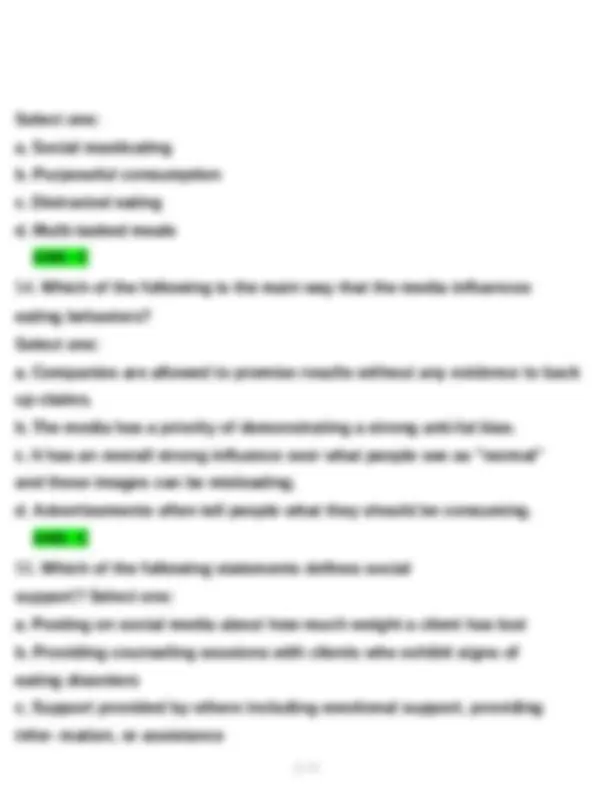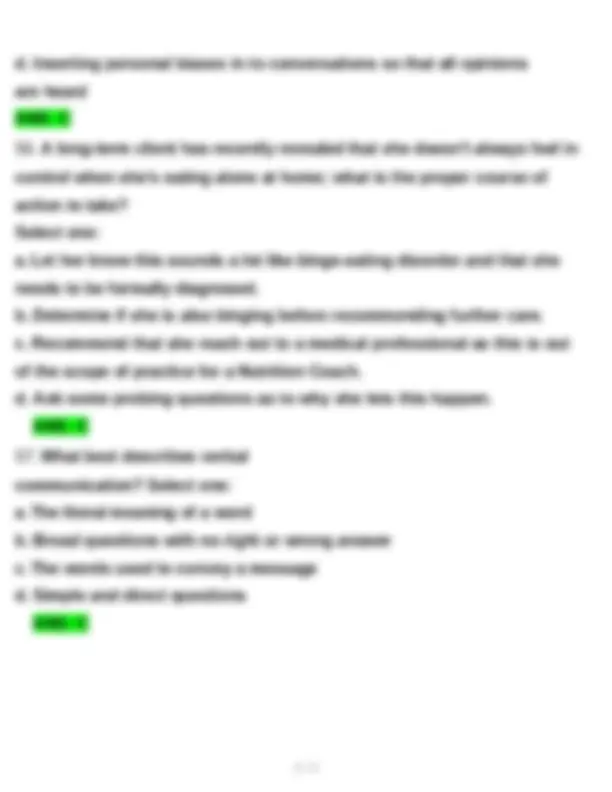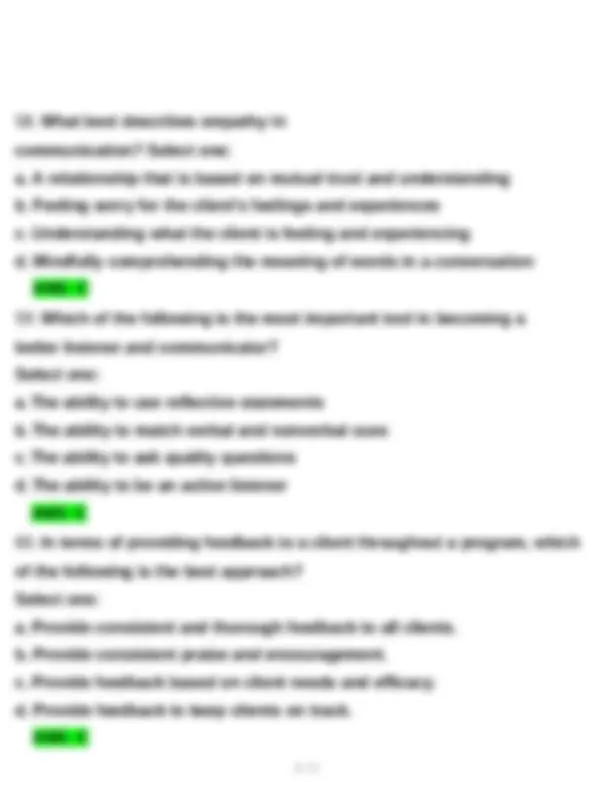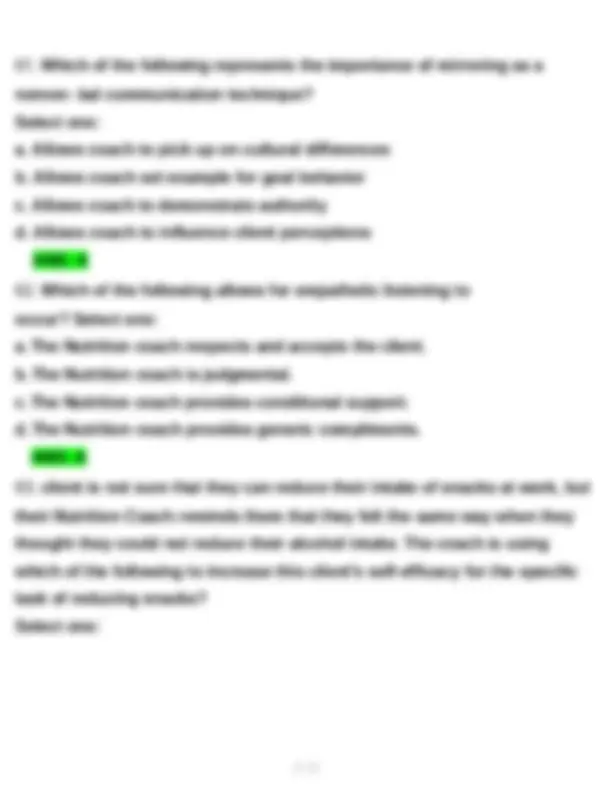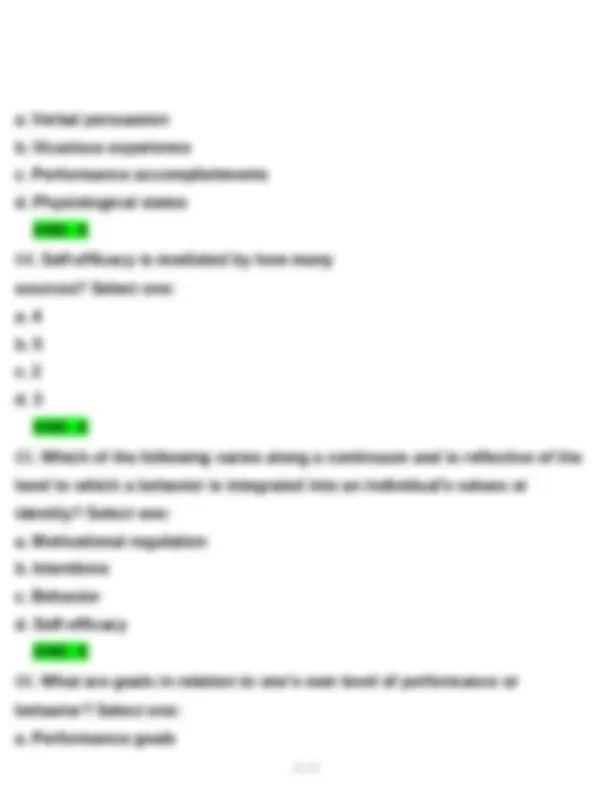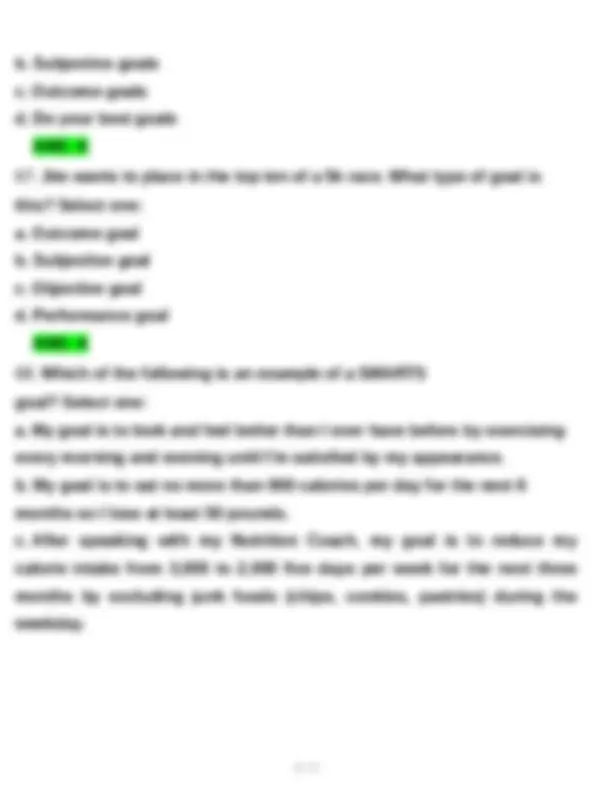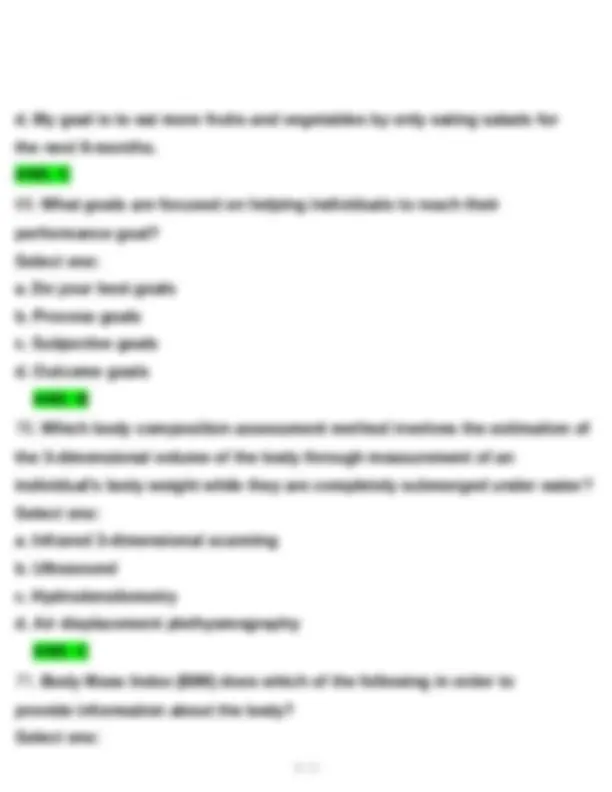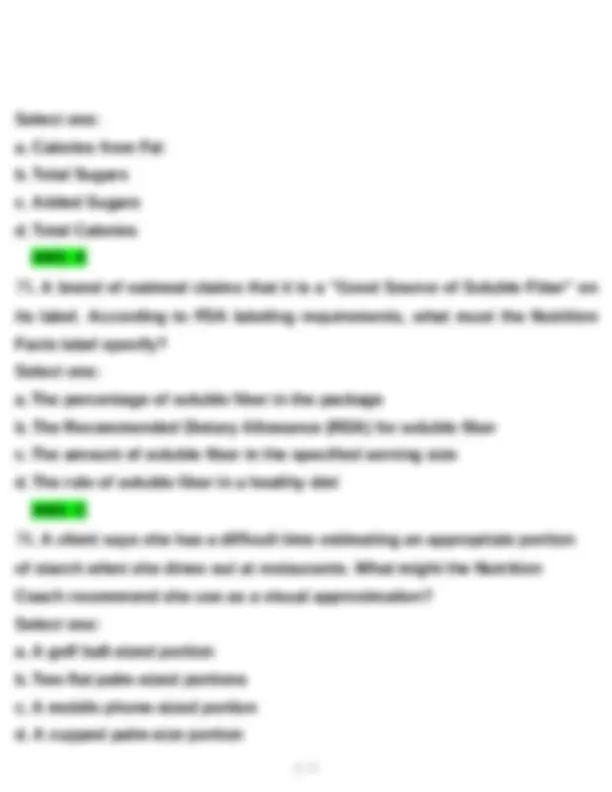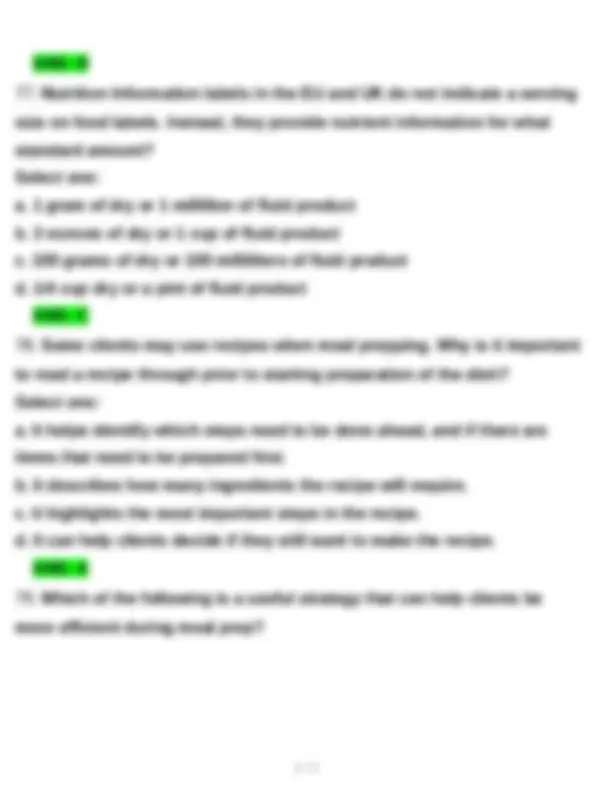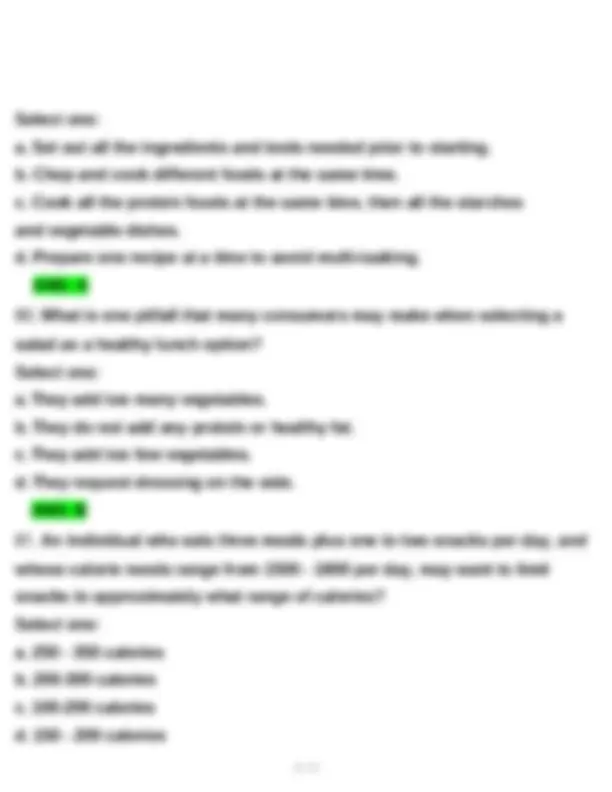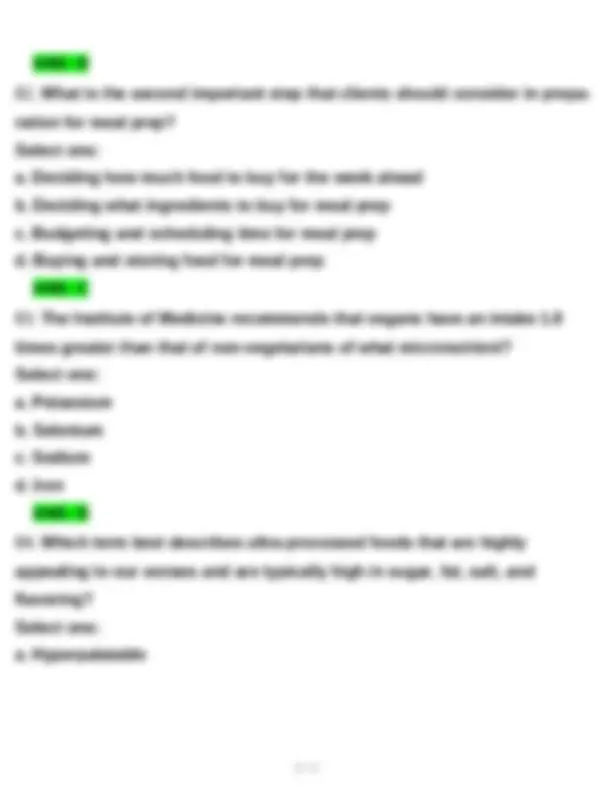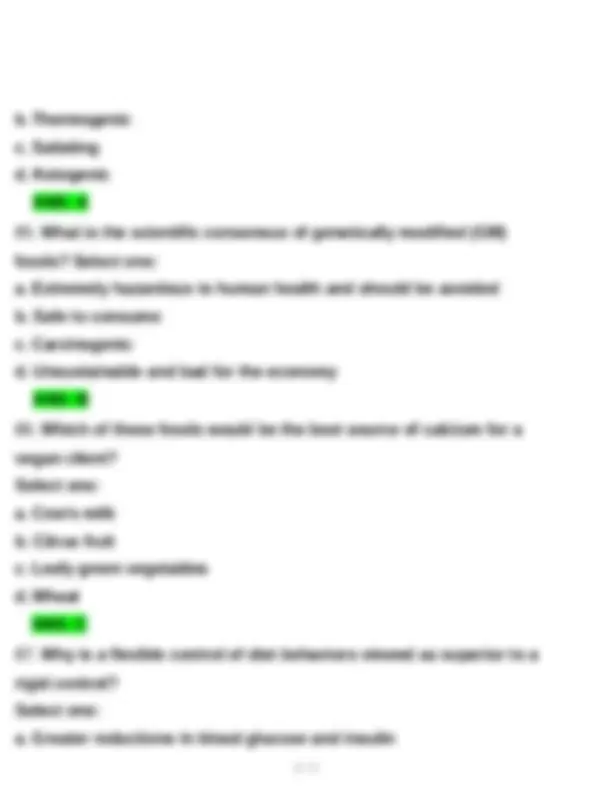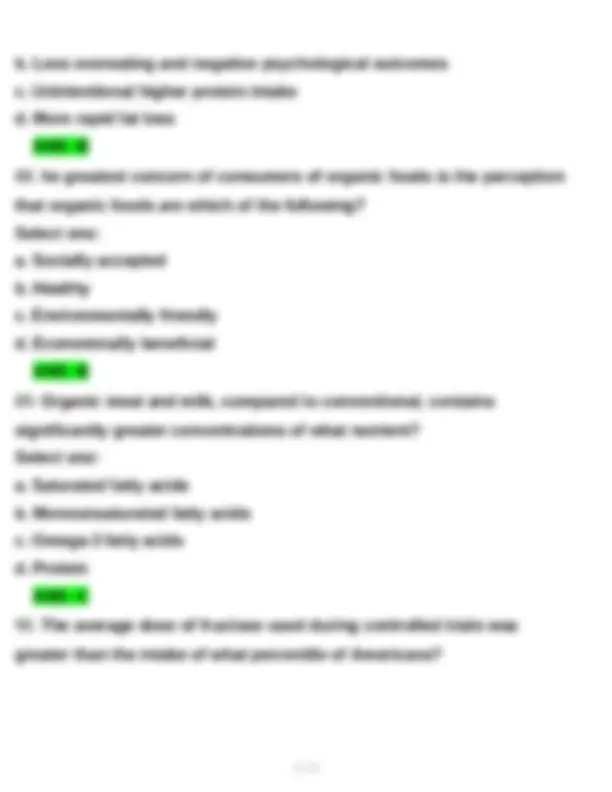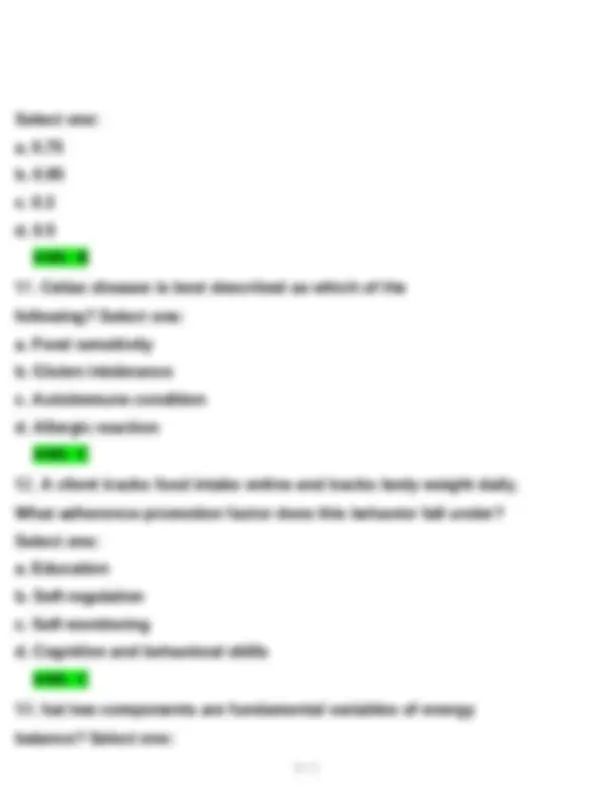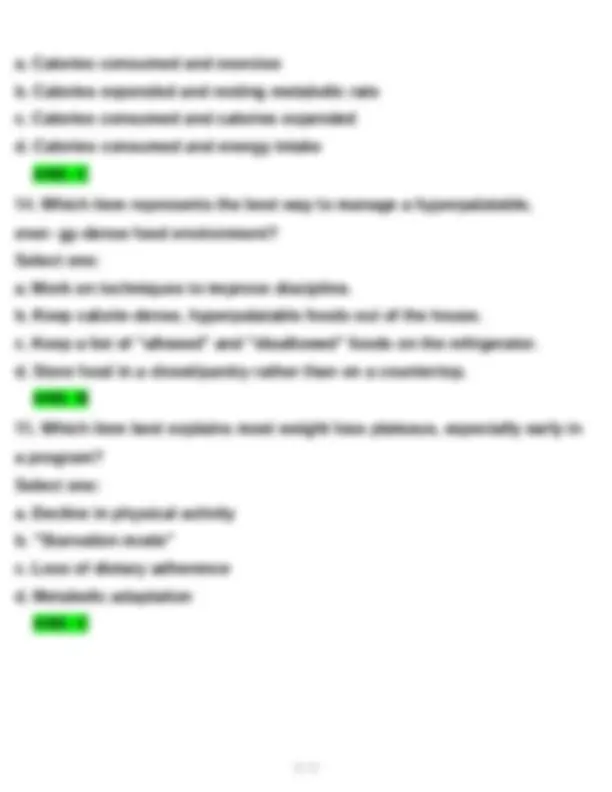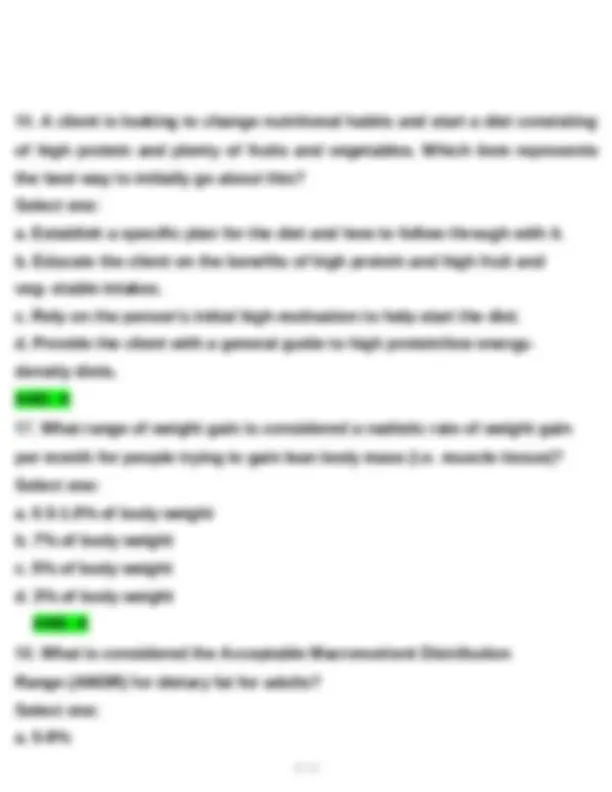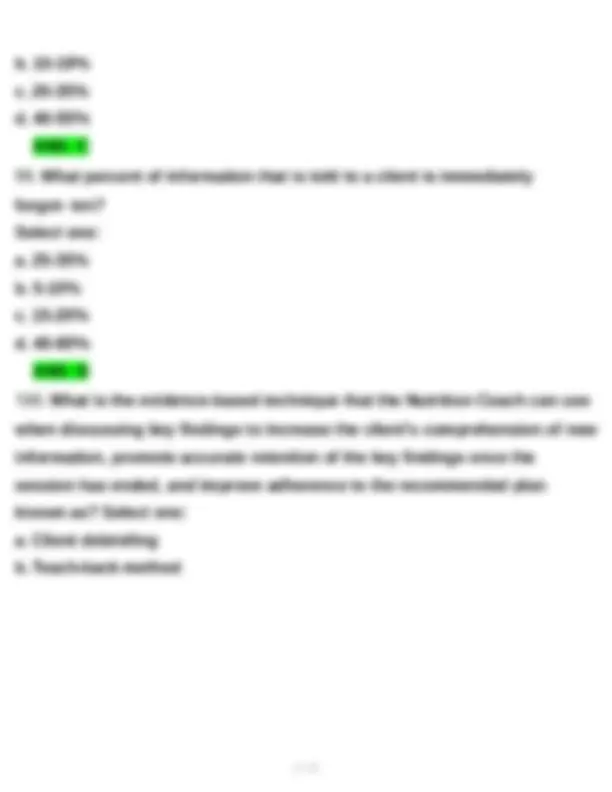Download NASM Nutrition Exam tested questions with revised correct answers, a+ guarantee and more Exams Nursing in PDF only on Docsity!
NASM Nutrition Exam Questions and Answers
(Verified by Expert)
- Common assessments performed by a Nutrition Coach include height, weight, body composition, and what other test? Select one: a. Blood pressure b. SCOFF test c. Hydrostatic weighing d. Anthropometric measurements ANS: D. Anthropometric measurements
- With which client would it be most appropriate for the Nutrition Coach to work? Select one: a. Clients considering training for a half-Ironman b. Issues with consistent weight loss c. Clients who wants to go vegan d. Clients who wants advice on supplements
ANS: B. Issues with consistent weight loss
- Where should client files be kept to ensure client confidentiality? Select one: a. In a locked and secure location b. In an electronic version only c. In the manager's office d. With the client ANS: A
- Clients often confide in the Nutrition Coach. Which client conversation would be grounds for a referral to a licensed healthcare professional? Select one: a. Chronic fatigue b. Late-night ice cream binging c. Slow weight loss of 1/2 pound per week (.22 kg) d. Occasional sleeplessness
b. Tell her she has bulimia and refer her to a Certified Eating Disorder Special- ist. c. Refer her to a clinical psychologist. d. Move forward with the client sessions but monitor her closely for any more self-induced vomiting . ANS: C
- Scientists take 5000 people and have them fill out questionnaires on their dairy intake. They then compare cancer rates between people with high in- takes and low intakes. What type of study is this? Select one: a. Anecdotal b. Meta-analysis c. Randomized controlled trial d. Observational ANS: D
- Which of the following is an example of descriptive research? Select one:
a. Cohort study b. Randomized controlled trial c. Survey d. Meta-analysis ANS: C
- Scientists perform a diet study in which they assign half the people to a continuous dieting group and the other half to an intermittent fasting group. Which term best describes this study design? Select one: a. Factorial b. Crossover c. Observational d. Parallel ANS: D
- Which of the following represents the lowest level of evidence? Select one: a. Peer reviewed editorials and expert opinion b. Randomized controlled trials c. Observational research d. Non-peer reviewed media
c. Faster metabolism d. Greater physical activity ANS: A
- Which of the following is best defined as the tendency toward a relative- ly stable equilibrium between interdependent elements, especially as main- tained by physiological processes? Select one: a. Homeopathic b. Heterogeneity c. Autostasis d. Homeostasis ANS: D
- Which of the following is a tip for a health-supporting diet? Select one: a. Follow a diet that is low in saturated fat. b. Include lots of processed meats in your diet. c. Follow a diet that is highly rigid and controlled.
d. Eat foods that are highly palatable . ANS: A
- To which of the following terms can 'non-communicable disease (NCD) also refer? Select one: a. Chronic diseases b. Curable diseases c. Infectious diseases d. Transient diseases ANS: A
- The process of generating energy (in the form of ATP) from nutrients we consume in our diet is referred to as which of the following? Select one: a. Energy metabolism b. Energy requirement c. Energy adaption d. Energy restriction ANS: A
- Energy utilized for immediate work is known as which of the
b. Catabolism c. Anabolism d. Metabolism ANS: D
- Between 1969/1971 and 1999/2001, global food consumption per person has risen by how much? Select one: a. Approximately 400 kcal per person per day b. Approximately 150 kcal per person per day c. Approximately 2,000 kcal per person per day d. Approximately 1,000 kcal per person per day ANS: A
- What are complementary protein sources? Select one: a. Meat and vegetables b. Any combination of plant-based foods c. 2 foods with incomplete proteins that, when eaten together, supply all the necessary essential amino acids d. Foods which do not cause any gastrointestinal discomfor ANS: C
- For an individual engaged in light aerobic exercise 2-3 days per week, what would be the most optimal protein prescription? Select one:
a. 3.0 g/kg weight b. 0.8 g/kg body weight c. 1.4 g/kg body weight d. 2.0 g/kg body weight ANS: C
- An existing client has been doing very well with meeting daily dietary recommendations with a 3-meal per day eating pattern, and they have met their goal to reach a healthy body weight with increased muscle tone. They express they would like to now pursue a new goal of a doing a physique competition within the next 12 months. Should the Nutrition Coach recommend they eat more or less frequently to help them meet their goals? Select one: a. A Nutrition Coach should recommend they continue eating 3 meals per day because protein timing is not important whatsoever. b. A Nutrition Coach should recommend they eat more frequent meals be- cause they can more frequently stimulate muscle growth. c. A Nutrition Coach does not need to make any recommendations because the goal is not that extreme. d. A Nutrition Coach should recommend they eat less frequent meals because
b. Sodium bicarbonate c. Chymotrypsin d. Potassium citrate ANS: B
- What disease associated with large intakes of fructose in inactive people has recently gained more attention as a health concern? Select one: a. Cirrhosis b. Hypertriglyridemia c. Hyperinsulemia d. Non-alcoholic liver disease ANS: D
- hich sweetener is not considered a mono- or disaccharide and is extracted from chicory root? Select one: a. Lactose b. High-fructose corn syrup c. Inulin d. Dextrose ANS: C
- The United States consumes more sugar than any other country in the world. From the options provided, what food category represents the largest
source of sugar intake in the U.S. diet? Select one: a. Snacks and sweets b. Fruit c. Beverages d. Dairy ANS: C
- Which two monosaccharides combine to make sucrose? Select one: a. Glucose and galactose b. Glucose and maltose c. Glucose and dextrose d. Glucose and fructose ANS: D
- What are both chylomicrons and very low-density lipoproteins responsible for transporting in the bloodstream? Select one: a. Ketone bodies b. Triglycerides c. Water-soluble vitamins d. Amino acids ANS: B
- What is the definition of
d. There is evidence that medium-chain triglycerides found in coconut oil raises the risk of diabetes. ANS: B
- A client tells his Nutrition Coach he is on a 2,100 kcal/day diet. If he is trying to consume 30% of his calories from fat, how many grams of fat should he be consuming? Select one: a. 367 grams of fat b. 70 grams of fat c. 163 grams of fat d. 156 grams of fat ANS: B
- Approximately how much ethanol is metabolized per hour? Select one: a. 14 grams b. 2 grams c. 10 grams d. 7 gram ANS: D
- After consuming alcohol, how much of the absorbed ethanol is metabo- lized in the liver? Select one: a. 0.
b. 0. c. 1 d. 0. ANS: B
- How many questions are there in the USAUDIT-C questionnaire? Select one: a. 2 b. 1 c. 3 d. 4 ANS: C
- What is the risk associated with drinking alcohol in cold environments? Select one: a. Dehydration b. Hypothermia c. Hyperthermia d. Hyperhydration ANS: B
- In what process does selenium play a critical role? Select one: a. Fatty acid metabolism b. Antioxidant system
d. 1-2% ANS: D
- A client's pre-exercise weight is 80.0 kg. Their post-exercise weight is 78.0 kg. They consumed 1.0 liters of fluid during training. What was the volume of their sweat loss? Select one: a. 3.0 liters b. 2.0 liters c. 1.0 liter d. 2.5 liters ANS: A
- Exercise associated hyponatremia is primarily caused by which of the following? Select one: a. Excess salt consumption b. Not consuming adequate electrolytes c. Not drinking enough sport beverages d. Excessive fluid intake ANS: D
- Where is approximately two-thirds of body water found? Select one: a. Extracellular fluid
b. Intracellular fluid c. Interstitial fluid d. Digestive system ANS: B
- Which of the following responses occurs during exercise associated hy- ponatremia? Select one: a. Intracellular fluid shifts outside of the cell. b. Extracellular fluid shifts inside cells. c. There is a large increase of sodium concentration in the extracellular fluid. d.There is a large increase in sodium concentration in the intracellular fluid. ANS: B
- What does the phrase "hitting the wall" mean? Select one: a. Most of the muscle's amino acids have been used up and the body is trying to convert other forms of stored energy (carbohydrate and fat) to glucose. b. Most of the person's glycerol and fatty acids have been used up and the body is trying to convert other forms of stored energy (amino acids and glycogen) to glucose. c. Most of the muscle glycogen stores have been used up and the body is trying to convert other forms of stored energy (lean tissue and fat) to glucose.

